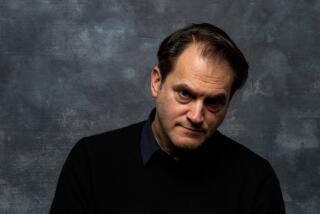Oliver Sacks dies at 82; neurologist wrote bestselling books on brain disorders
- Share via
When he was a young doctor on the neurology ward at UCLA, Oliver Sacks was every bit as unconventional as he seemed in the bestselling books he later wrote about treating patients who were stricken with a bizarre and frightening variety of brain disorders.
When a terminally ill patient, blind and paralyzed, learned that Sacks was an avid motorcyclist, she had one final wish: a ride with him along the twisting ups and downs of Topanga Canyon Boulevard.
“I came to the hospital one Sunday with three weight-lifting buddies,” Sacks wrote in “On the Move”, his 2015 memoir, “and we managed to abduct the patient and lash her securely to me on the back of the bike.”
See the most-read stories this hour >>
Sacks wrote that he was nearly fired when his superiors heard about the unauthorized outing, but his colleagues — and his patient — stood up for him.
Sacks, who sought to humanize people with brain disorders by focusing on their resiliency and, in some cases, the extraordinary abilities with which their diseases endowed them, died Sunday at his home in New York. He was 82.
The cause was cancer, his assistant Kate Edgar said.
Last February, he announced that the cancer that began in an eye years ago had metastasized to his liver.
“It is up to me now to choose how to live out the months that remain to me,” he wrote in an essay for the New York Times. “I have to live in the richest, deepest, most productive way I can.”
He continued: “I want and hope in the time that remains … to achieve new levels of understanding and insight.”
NEWSLETTER: Get the day’s top headlines from Times Editor Davan Maharaj >>
Sacks, who was once called “the poet laureate of medicine,” tried to shed light on the human condition through his study of people suffering from illnesses caused by an aberrant brain.
“Through them I would explore what it was like to be human, to stay human, in the face of unimaginable adversities and threats,” Sacks wrote in his 1973 book “Awakenings.” That account was later turned into an Oscar-nominated 1991 film, starring Robin Williams as a fictionalized Sacks and Robert De Niro as a patient.
With more than a dozen books to his credit, including the 1985 bestseller “The Man Who Mistook His Wife for a Hat and Other Clinical Tales,” Sacks combined the accuracy of a clinician, the sensibility of a novelist and the empathy of a friend.
Sometimes he wrote about his own ailments, as in his first book, “Migraine” (1970). But it was “Awakenings” that catapulted him into the spotlight.
A compilation of case studies, it chronicled patients who had spent years frozen in time because of post-encephalitic Parkinsonism, also known as sleeping sickness, which was prevalent just after World War I.
Among them was Miss R., who was stricken in 1926 at the age of 21. For 43 years, she was stuck in a state of unnatural concentration that nothing could penetrate. Her face was masked and expressionless, her voice an inaudible whisper. At times she suffered severe tremors of the head, lip and tongue. “It’ll kill me, it’ll kill me,” she kept repeating.
After reading about a drug for Parkinson’s disease, Sacks gave it to his patients with sleeping sickness. The results were astonishing: Miss R. and her fellow patients came to life, as if they were “corks suddenly released from a great depth,” Sacks wrote.
Miss R. walked, chatted, played piano, sang and told jokes. But her mannerisms, anecdotes and allusions were straight from the 1920s. Figuring out how to help patients orient themselves in the modern world was part of Sacks’ challenge.
Use of the drug was later halted, in part because of negative side effects. As Sacks watched his patients return to their catatonic states, he wondered whether their awakening had caused more harm than good.
“One or two of them said to me, ‘You open the window and you raise unbearable hopes and prospects. And now you close it,’” Sacks said in a 1991 interview with the Washington Post.
Oliver Wolf Sacks was born in London on July 9, 1933, the youngest of four sons. His mother was a surgeon and the first woman allowed to join the Royal College of Physicians and Surgeons. His father, a general practitioner, was still treating patients when he was 90.
When World War II began, 6-year-old Sacks and one of his brothers were sent to boarding school in the village of Braefield. It was a nightmarish experience for the boys, who suffered at the hands of an abusive headmaster.
Sacks returned to London as “a traumatized 10-year-old, distrustful of humans.” He turned to chemistry and became enamored with the periodic table of elements. It was stable, predictable, constant in a way that people were not. Throughout his life he carried a copy in his wallet.
Fascinated with science, he created a lab in his basement. When he was 11, his mother had him dissect human fetuses; at 14, she arranged for him to dissect a leg that had belonged to a girl his age. The experience changed him.
“I did not know if I would ever be able to love the warm, quick bodies of the living after facing, smelling and cutting the formalin-reeking corpse of a girl my own age,” he wrote in his 2001 memoir, “Uncle Tungsten: Memories of a Chemical Boyhood.”
In his 2015 autobiography, Sacks disclosed that he was gay. He had been in a relationship with writer Billy Hayes since 2008.
------------
FOR THE RECORD
Aug. 30, 9:35 a.m.: An earlier version of this post on writer and neurologist Oliver Sacks indicated that, by some accounts, he was celibate. In his 2015 autobiography, he disclosed that he was gay. He was in a relationship with writer Billy Hayes since 2008.
------------
Sacks received his bachelor’s and medical degrees from Queen’s College, Oxford. In 1960 he moved to the United States, first to San Francisco and then to Southern California, where he spent three years as a resident in neurology at UCLA.
During his California years he became an avid weightlifter and experimented with recreational drugs. In San Francisco, he charmed a group of Hells Angels with his friendliness and British accent.
“I was pleasant, unjudgmental, and a doctor,” he wrote, “and as such was called on, occasionally, to advise when riders were injured.”
Sacks was an acknowledged klutz. He fell and tore the muscles and nerves of one leg and wrote about his experiences in “A Leg to Stand On” (1984). Later, he fell again and suffered similar damage in the other leg.
Sacks had planned to become a researcher, but it didn’t work out. After he accidentally dropped bits of hamburger into a centrifuge, he was gently told by one of his bosses that he was “a menace in the lab.” Urged on by colleagues, he found his way into clinical work and never looked back.
“There are a million people with chronic neurological disease locked away in this country,” he told the Washington Post in 1991. “They are sort of dismissed and regarded as defective. But it isn’t so.”
Sacks treated patients at Beth Abraham Hospital in the Bronx from 1966 until 2007, as well as in nursing homes and other venues. He served as a professor of neurology and psychiatry at Albert Einstein College of Medicine in New York, New York University and Columbia University.
The discovery that gained him fame drew criticism from some of his colleagues, who objected to his use of the drug, L-dopa, in a round of letters to the Journal of the American Medical Assn. Sacks responded by assisting in a documentary about his work that included interviews with his patients.
A recurrent theme in Sacks’ writing is the notion that disorder, however dark and difficult, may be more than a deficit.
In “An Anthropologist on Mars,” Sacks introduced readers to Dr. Carl Bennett. He suffered from Tourette’s syndrome, which causes compulsive and uncontrollable touching, lunging, verbal outbursts and other tics. Though it seems unfathomable, Bennett was a surgeon and a pilot. Tourette’s “made him more meticulous, more exact,” Sacks wrote.
In “The Man Who Mistook His Wife for a Hat,” Sacks describes the case of Natasha K., an 89-year-old patient who experienced a sudden euphoria — she was more energetic, more alive and interested in young men.
Nearly 70 years earlier, in the days before penicillin, she had contracted syphilis and was treated but not cured. The latent disease had come back in full flower — and the patient was in no hurry to be rid of it.
“I know it’s an illness, but it’s made me feel well,” she said.
Sacks was stunned.
“What a paradox, what a cruelty, what an irony, there is here — that inner life and imagination may lie dull and dormant unless released and awakened, by an intoxication or disease!” he wrote.
Though he lived in the U.S. since the 1960s, Sacks never became a citizen. Given the work to which he dedicated his life, being an observer seemed to suit him.
“Generally, wherever I am, I regard myself as a visitor,” Sacks said in a 1997 Newsday article. “I do partly feel myself an outsider. I guess I always have.”
Stewart is a former Times staff writer.
More to Read
Start your day right
Sign up for Essential California for the L.A. Times biggest news, features and recommendations in your inbox six days a week.
You may occasionally receive promotional content from the Los Angeles Times.







